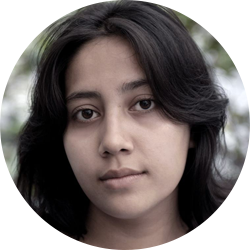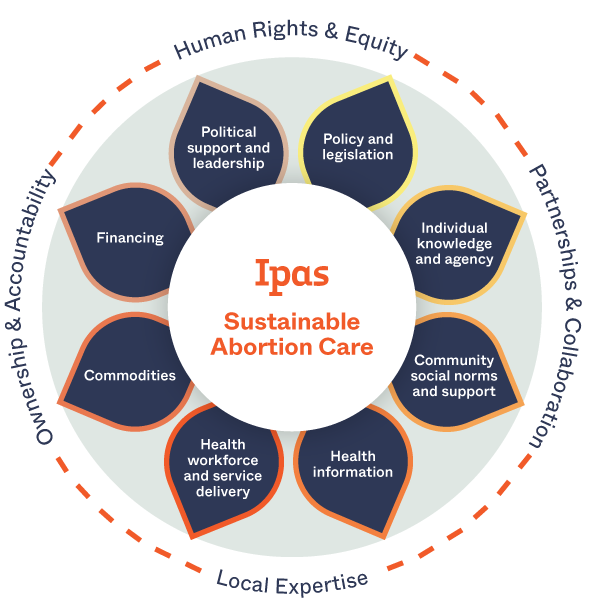 In 2017, Ipas commissioned photographer Farzana Hossen to document the experiences of women seeking reproductive health care services in Rohingya refugee camps, where Ipas Bangladesh has been working with partners to improve access to reproductive health services. She found that many women and girls in these camps had experienced unimaginable violence, like Noor, who was raped by members of Myanmar’s military and became pregnant.
In 2017, Ipas commissioned photographer Farzana Hossen to document the experiences of women seeking reproductive health care services in Rohingya refugee camps, where Ipas Bangladesh has been working with partners to improve access to reproductive health services. She found that many women and girls in these camps had experienced unimaginable violence, like Noor, who was raped by members of Myanmar’s military and became pregnant.
Ipas has produced an exhibit of Hossen’s photos of Rohingya refugees, which has been hosted at the Embassy of Denmark in Washington, D.C.; with Action Canada for Sexual Health and Rights in Ottawa, Canada; and at the International Conference on Family Planning 2018 in Kigali, Rwanda.
In this Q&A, we learn about Hossen’s background and experiences, and her observations on life in refugee camps.
This interview has been lightly edited and condensed.
What made you want to be a photographer?
It wasn’t my intention to be a photographer, but over time, my hunger to know more about photography grew. I knew I had found a precious medium which allows me to raise my voice against the unjust. I wanted to show how conflict can work against human rights. I want my work to make people think about and discuss what is often hidden from the world.
Why were you interested in Ipas’s proposal to document the reproductive health issues facing women in the Rohingya camps?
When Ipas contacted me, I was already working in the camps and very much aware of the issues. I knew that the project would support women in the camps, which they needed. I was impressed with Ipas and I knew this could be an important collaboration on a critical situation.
How does it feel to be a woman in a male-dominated field?
Being a woman in a male-dominated society is always hard, and the photography field is truly male-dominated worldwide. I’ve faced many difficulties, but I feel empowered, too, because overcoming challenges gives me strength. I become more confident day by day.
In a conservative society like mine, I am constantly reminded that I am a woman, rather than a person. Sometimes it has depressed me, but I try to motivate myself by remembering that I am challenging stereotypes about women. I have heard so many times, “When we first saw you, we didn’t realize that you could work this hard!” I smile and ask, “How can you judge someone’s abilities just by looking at them?”
What were the conditions of the camp like?
The camps are in miserable condition. People are crossing the border to save their lives, leaving everything. Over a million people live in tents, with zero basic facilities, and the number is increasing. Lack of privacy makes the situation harsher for women; most women and girls stay in their tiny tents all the time. People live with the trauma of violence they faced in Myanmar, and uncertainty makes their souls vulnerable. They are in a new cage; they might not fear being killed at any moment, but they have a similar feeling of suffocation that they had back home.
Did you find that there was stigma in the camp about being raped?
Yes, the Rohingya people are conservative and concerned with family honor. For example, one woman couldn’t flee with her family when the military came—she was pregnant and couldn’t run. She was brutally raped, found senseless and bleeding. After, her husband wanted to leave her because she had been raped. She told me, “I was lucky that my mother-in-law is my own aunt. She helped my husband understand that it wasn’t my fault. She asked him to stay with me for our children. He accepts me, but our relationship is not the same. His negligence hurts me.” Often, women are afraid to lose their families and they don’t want to share what happened to them.
Do you ever feel threatened while doing your work?
Yes. While doing my documentary work “Lingering Scars”—on acid violence in Rangpur, Bangladesh—I would visit Moni, an acid attack survivor who had had been disfigured and blinded. She had to stop her high school studies and stay home, since she couldn’t move without help. We would spend whole days together, talking. But every evening, when the time came to leave, I felt scared. Moni’s attacker lived nearby and hadn’t been caught by the police. Sometimes her mother or brother accompanied me and helped me find a vehicle to my hotel.
Another time, I was working in a slum on a project about forced marriage. It was a crime zone and unsafe at night. One evening, when I was talking to a girl about her forced marriage, her husband came to their tiny house with 10 or 12 men. They had me sit and they interrogated me—they thought I was a trafficker. Luckily, I was able to text a friend; he came and we managed to leave. The next morning, I returned. The girl said her husband was angry with her for sharing her story with me.
What is your most vivid memory of the Rohingya camps?
I was walking through Balukhali camp with an elderly Rohingya man, a teacher, and he was sharing horrible stories from Rakhine State. He wanted me to meet a woman who had been raped and forced by the military to throw her child into the fire and watch. They slaughtered her husband in front of her and her child. At her tent, I heard weeping. She was sitting with her two children who were able to escape. They weren’t crying, just sitting quietly. They were always seen sitting beside her—never playing, never talking to anyone or collecting any relief. I ran away, crying. I was so overwhelmed; I couldn’t even talk to them, let alone take photographs.
What do you think of Ipas’s traveling exhibit?
It’s an important issue and we need to discuss it to make people aware. I appreciate that Ipas has paid attention to this and showed to the world what has happened with the Rohingya women through their stories. I am happy that I could be a part of the work.
For more information, contact [email protected].

